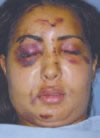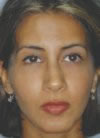Pathology and Trauma
Treating and Preventing Facial Injury
Maxillofacial injuries, also referred to as facial trauma, encompass any injury to the mouth, face and jaw. Almost everyone has experienced such an injury, or knows someone who has. Most maxillofacial injuries are caused by a sports mishap, motor vehicle accident, on-the-job accident, act of violence or an accident in the home.
If a person is unconscious, disoriented, nauseated, dizzy or otherwise incapacitated, call 911 immediately. Do not attempt to move the individual yourself. If these symptoms are not present but the injury is severe or you are uncertain about its severity, take the person to the nearest hospital emergency room as quickly as possible.
Oral and Maxillofacial Surgeons Treat Injuries to Teeth, Mouth, Jaws and Facial Structures
At the hospital, the individual will most likely be seen by several medical personnel, one of whom will probably be an oral and maxillofacial surgeon. Oral and maxillofacial surgeons, the surgical specialists of the dental profession, are specifically trained to repair injuries to the mouth, face and jaws. After four years of dental school, oral and maxillofacial surgeons complete four or more years of hospital-based surgical residency training that may include rotations through related medical fields, including internal medicine, general surgery, anesthesiology, otolaryngology, plastic surgery, emergency medicine and other medical specialty areas.
At the conclusion of this demanding program, oral and maxillofacial surgeons are well-prepared to perform the full scope of the specialty, which includes emergency care for the teeth, mouth, jaws, and associated facial structures.
 (a) (a) |
Extensive maxillofacial fractures are often accompanied by other medical problems. The oral and maxillofacial surgeon coordinates treatment with other medical specialties to return the patient to their normal activities as soon as possible. The young woman pictured in fig. (a) prior to surgery and (b) following surgery to repair her injuries. |
 (b) (b) |
Treating Facial Injury
One of the most common types of serious injury to the face occurs when bones are broken. Fractures can involve the lower jaw, upper jaw, palate, cheekbones, eye sockets and combinations of these bones. These injuries can affect sight and the ability to breathe, speak and swallow. Treatment often requires hospitalization.
The principles for treating facial fractures are the same as for a broken arm or leg. The parts of the bone must be lined up (reduced) and held in position long enough to permit them time to heal. This may require six or more weeks depending on the patient’s age and the fracture’s complexity.
When maxillofacial fractures are complex or extensive, multiple incisions to expose the bones and a combination of wiring or plating techniques may be needed. The repositioning technique used by the oral and maxillofacial surgeon depends upon the location and severity of the fracture. In the case of a break in the upper or lower jaw, for example, metal braces may be fastened to the teeth and rubber bands or wires used to hold the jaws together. Patients with few or no teeth may need dentures or specially constructed splints to align and secure the fracture. Often, patients who sustain facial fractures have other medical problems as well. The oral and maxillofacial surgeon is trained to coordinate his or her treatment with that of other doctors.
During the healing period when jaws are wired shut, the oral and maxillofacial surgeon prescribes a nutritional liquid or pureed diet, which will help the healing process by keeping the patient in good health. After discharge from the hospital, the doctor gives the patient instructions on continued facial and oral care.
Don’t Treat Any Facial Injury Lightly
While not all facial injuries are extensive, they are all complex since they affect an area of the body that is critical to breathing, eating, speaking and seeing. Even in the case of a moderately cut lip, the expertise of the oral and maxillofacial surgeon is indispensable. If sutures are needed, placement must be precise to bring about the desired cosmetic result. So a good rule of thumb is not to take any facial injury lightly.
Prevention — The Best Policy
Because avoiding injury is always best, oral and maxillofacial surgeons advocate the use of automobile seat belts, protective mouth guards, and appropriate masks and helmets for everyone who participates in athletic pursuits at any level. You don’t have to play at the professional level to sustain a serious head injury. New innovations in helmet and mouth and face guard technology have made these devices comfortable to wear and very effective in protecting the vulnerable maxillofacial area. Make sure your family is well-protected. If you play the sport, make the following safety gear part of your standard athletic equipment.
Reprinted with permission from American Association of Oral and Maxillofacial Surgeons.

